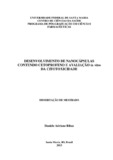| dc.creator | Ribas, Daniele Adriane | |
| dc.date.accessioned | 2015-02-25 | |
| dc.date.available | 2015-02-25 | |
| dc.date.issued | 2013-08-28 | |
| dc.identifier.citation | RIBAS, Daniele Adriane. DEVELOPMENT OF NANOCAPSULES CONTAINING KETOPROFEN AND in vitro EVALUATION OF CYTOTOXICITY. 2013. 67 f. Dissertação (Mestrado em Farmacologia) - Universidade Federal de Santa Maria, Santa Maria, 2013. | por |
| dc.identifier.uri | http://repositorio.ufsm.br/handle/1/5989 | |
| dc.description.abstract | The aim of this work was to prepare, characterize and evaluate the in vitro cytotoxicity of Eudragit S100® nanocapsules (NC) containing ketoprofen. The nanostructured suspensions were prepared in triplicate by the method of interfacial deposition of preformed polymer. Caprilic/capric triglyceride or rosehip oil were used as the oil core in the preparation of such formulations. Previously, tests of swelling/dissolution of the films of Eudragit S100® were performed and showed the feasibility of using both oils as the core of the NC. The results of the physico-chemical characterization of the systems (pH, size, zeta potential, content, encapsulation efficiency) showed no significant differences between the various types of formulations. The concentration of ketoprofen in the formulations was very close to the theoretical concentration, indicating no loss or degradation of the drug during the preparation process. The encapsulation efficiency of ketoprofen in NC was higher than 90%. The particle size of the formulations was found in the range of 173-197 nm, which is in accordance to the method of preparation employed. Regarding the in vitro release, the mathematical analysis of the profiles showed a first order kinetics with drug diffusion as release mechanism. In order to evaluate the influence of the oil component in the ketoprofen photodegradation, samples were exposed to UVC radiation. The photodegradation was less evident in the rosehip oil NC, probably due to the greatest antioxidant potential of this oil. The in vitro cytotoxicity assay evaluated the viability of 3T3 cell line against four concentrations of ketoprofen (1, 10, 50 and 100 μM) for 24 and 48 hours. After 48 hours of exposure, there was a reduction in cell viability in all tested groups. However, this decrease was not significantly different from the control group. Thus, the prepared formulations can be considered promising alternatives for the delivery of ketoprofen in inflammatory diseases such as rheumatoid arthritis. | eng |
| dc.format | application/pdf | por |
| dc.language | por | por |
| dc.publisher | Universidade Federal de Santa Maria | por |
| dc.rights | Acesso Aberto | por |
| dc.subject | Nanopartículas | por |
| dc.subject | Nanocápsulas | por |
| dc.subject | Cetoprofeno | por |
| dc.subject | Óleo de rosa mosqueta | por |
| dc.subject | Eudragit S100® | por |
| dc.subject | Citotoxicidade | por |
| dc.subject | Nanoparticles | eng |
| dc.subject | Nanocapsules | eng |
| dc.subject | Ketoprofen | eng |
| dc.subject | Rosehip oil | eng |
| dc.subject | Cytotoxicity | eng |
| dc.title | Desenvolvimento de nanocápsulas contendo cetoprofeno e avaliação in vitro da citotoxicidade | por |
| dc.title.alternative | Development of nanocapsules containing ketoprofen and in vitro evaluation of cytotoxicity | eng |
| dc.type | Dissertação | por |
| dc.description.resumo | O objetivo deste trabalho foi preparar, caracterizar e avaliar in vitro a citotoxicidade de nanocápsulas (NC) de Eudragit S100® contendo cetoprofeno. As suspensões nanoestruturadas foram preparadas em triplicata pelo método de deposição interfacial do polímero pré-formado. Triglicerídeos de cadeia média (TCM) ou óleo de rosa mosqueta (ORM) foram utilizados como núcleo oleoso na preparação de tais formulações. Previamente, foram realizados testes de inchamento/dissolução dos filmes de Eudragit S100®, os quais revelaram a viabilidade do emprego de ambos os óleos como núcleo das NC. Os resultados da caraterização físico-química dos sistemas (pH, tamanho, potencial zeta, teor, eficiência de encapsulamento) não demonstraram diferenças consideráveis entre os diferentes tipos de formulações. O teor de cetoprofeno nas suspensões nanoestruturadas foi muito próximo à concentração teórica, indicando ausência de perda ou degradação do fármaco durante o processo de preparação. Obteve-se uma taxa de associação do cetoprofeno às NC superior a 90%. O tamanho de partícula nas formulações encontrou-se na faixa de 173 a 197 nm, resultados compatíveis com o método de preparação empregado. Quanto à liberação in vitro, a análise matemática dos perfis demonstrou uma cinética de primeira ordem com difusão do fármaco como mecanismo de liberação. A fim de avaliar a influência do componente oleoso frente à fotodegradação do cetoprofeno, amostras foram expostas à radiação UVC. A fotodegradação foi menos evidente nas NC contendo ORM como núcleo, possivelmente pelo maior potencial antioxidante deste óleo. O teste de citotoxicidade in vitro avaliou a sobrevivência de fibroblastos da linhagem 3T3 frente a quatro concentrações de cetoprofeno (1, 10, 50 e 100 μM) em 24 e 48 horas. Após 48h de exposição, observou-se uma redução da viabilidade celular para todos os grupos testados. Contudo, esta diminuição não foi diferente significativamente do grupo controle. Desta forma, as formulações preparadas podem ser consideradas promissoras para veiculação do cetoprofeno em doenças como a artrite reumatoide. | por |
| dc.contributor.advisor1 | Cruz, Letícia | |
| dc.contributor.advisor1Lattes | http://lattes.cnpq.br/3095970241017527 | por |
| dc.contributor.referee1 | Silva, Ana Luiza Maurer da | |
| dc.contributor.referee1Lattes | http://lattes.cnpq.br/8113347790962637 | por |
| dc.contributor.referee2 | Canto, Gizele Scotti do | |
| dc.contributor.referee2Lattes | http://lattes.cnpq.br/2076175621657265 | por |
| dc.creator.Lattes | http://lattes.cnpq.br/3958761319620202 | por |
| dc.publisher.country | BR | por |
| dc.publisher.department | Farmacologia | por |
| dc.publisher.initials | UFSM | por |
| dc.publisher.program | Programa de Pós-Graduação em Ciências Farmacêuticas | por |
| dc.subject.cnpq | CNPQ::CIENCIAS BIOLOGICAS::FARMACOLOGIA | por |


